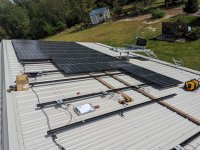electrofelon
Senior Member
- Location
- Cherry Valley NY, Seattle, WA
- Occupation
- Electrician
I have a job with a steep 12/12 pitch corrugated thru fastener roof. It works out that to squeeze the max amount of PV on the roof, the modules will need to be mounted in landscape. The question is which way should the rails run? East West uses twice the rail footage, so more cost and more time, but on the other hand would make for lots of nice "stops" to stand against and put stuff against while working. Obviously with up/down orientation, I would be at t he mercy of the rib spacing, but module mounting location seems flexible enough that that would not matter. I mostly do ground mounts so I would love some input from the roof guys who have more hands on with roofs.
.
.


